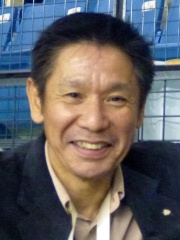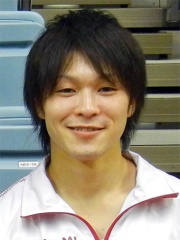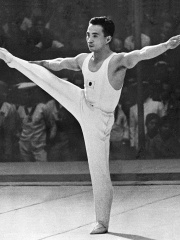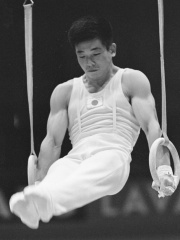
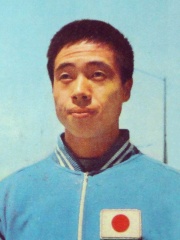
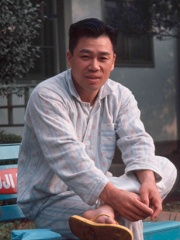
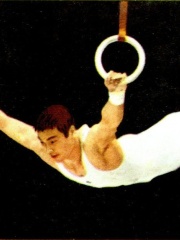
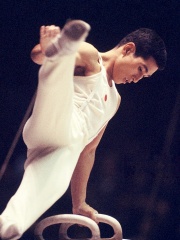
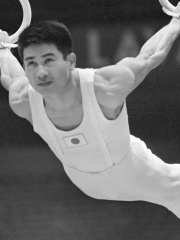
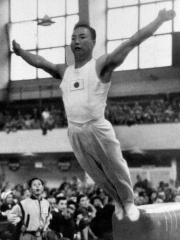
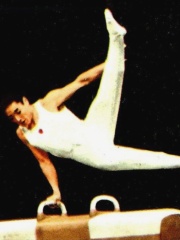
The Most Famous
GYMNASTS from Japan
Top 10
The following people are considered by Pantheon to be the top 10 most legendary Japanese Gymnasts of all time. This list of famous Japanese Gymnasts is sorted by HPI (Historical Popularity Index), a metric that aggregates information on a biography's online popularity. Visit the rankings page to view the entire list of Japanese Gymnasts.

1. Akinori Nakayama (1943 - 2025)
With an HPI of 66.13, Akinori Nakayama is the most famous Japanese Gymnast. His biography has been translated into 27 different languages on wikipedia.
Akinori Nakayama (中山 彰規, Nakayama Akinori; March 1, 1943 – March 9, 2025) was a Japanese gymnast and Olympic gold medalist. Nakayama was born in Nagoya, Aichi Prefecture, and is a graduate of Chukyo University in Nagoya. Nakayama is one of only three gymnasts to become an Olympic Champion in rings twice.

2. Sawao Kato (b. 1946)
With an HPI of 65.77, Sawao Kato is the 2nd most famous Japanese Gymnast. His biography has been translated into 38 different languages.
Sawao Katō (加藤 澤男, Katō Sawao; born October 11, 1946) is a Japanese former gymnast and one of the most successful Olympic athletes of all time. Between 1968 and 1976 he won twelve Olympic medals, including eight gold medals, making him the most successful Japanese Olympian by number of gold medals won.

3. Takashi Ono (b. 1931)
With an HPI of 60.82, Takashi Ono is the 3rd most famous Japanese Gymnast. His biography has been translated into 27 different languages.
Takashi Ono (小野 喬, Ono Takashi; born 26 July 1931) is a retired Japanese gymnast. He competed at the 1952, 1956, 1960 and 1964 Olympics and won five gold, four silver and four bronze medals, making him the most decorated Japanese athlete and fourth-most decorated gymnast in Olympic history by number of total medals won. Ono was the flag bearer for Japan at the 1960 Olympics, and took the Olympic Oath at the 1964 Games. In 1998, he was inducted into the International Gymnastics Hall of Fame.

4. Mitsuo Tsukahara (b. 1947)
With an HPI of 59.56, Mitsuo Tsukahara is the 4th most famous Japanese Gymnast. His biography has been translated into 25 different languages.
Mitsuo Tsukahara (塚原 光男 Tsukahara Mitsuo, born December 22, 1947) is a Japanese artistic gymnast. He was five times an Olympic Gold Medalist. He remained active in the sport after his retirement from competition. He served as vice president of the Japan Gymnastic Association. Tsukahara competed throughout the late 1960s and 1970s, retiring from gymnastics competition in 1978 after the World Championships. Winning five gold, one silver and three bronze medals, Tsukahara was an important contributor in Japan's win at the team competition in three consecutive Olympic Games: in 1968, 1972 and 1976. He married fellow gymnast Chieko Oda. He has remained connected to the gymnastics world, partly through his son Naoya Tsukahara, who was also a multi-medalist at the World Championships and Olympic Games throughout the late 1990s and who still competed as of 2014.
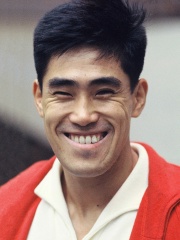
5. Yukio Endo (1937 - 2009)
With an HPI of 57.42, Yukio Endo is the 5th most famous Japanese Gymnast. His biography has been translated into 25 different languages.
Yukio Endō (遠藤 幸雄, Endō Yukio; January 18, 1937 – March 25, 2009) was a Japanese artistic gymnast, Olympic champion and world champion. He was part of the first Japanese team that succeeded to win gold medals in the team event at the Summer Olympics (1960) and World Championships (1962). In 1964 he won the first individual all-around Olympic gold medal for Japan. He was the flag bearer at the 1968 Summer Olympics.

6. Haruhiro Yamashita (b. 1938)
With an HPI of 55.15, Haruhiro Yamashita is the 6th most famous Japanese Gymnast. His biography has been translated into 19 different languages.
Haruhiro Yamashita (山下 治広, Yamashita Haruhiro; born November 11, 1938) is a Japanese gymnast, who competed in the 1964 Summer Olympics. He won two gold medals, in the vault and team combined exercises. After marriage he changed his last name from Yamashita to Matsuda (松田), adopting his aunt's surname, who took care of him as a child. In 1961, he graduated from Nippon Sport Science University, where in 1983 he became professor and later professor emeritus. In the early 1970s he was an assistant gymnastics coach under Roger Council at the Indiana State University. There he began his research on biorhythms. Yamashita also trained the national gymnastics team, at the 1976 Summer Olympics and at the Asian Games in 1990, and held senior positions with the Japan Gymnastics Association. In 2000 Yamashita was inducted into the International Gymnastics Hall of Fame. He is an honorary citizen of his native town of Uwajima.

7. Shuji Tsurumi (b. 1938)
With an HPI of 55.00, Shuji Tsurumi is the 7th most famous Japanese Gymnast. His biography has been translated into 18 different languages.
Shuji Tsurumi (鶴見 修治, Tsurumi Shūji; born January 29, 1938) is a Japanese gymnast and Olympic champion. He was part of the first Japanese team that succeeded to win gold medals in the team event at the Summer Olympics (1960) and World Championships (1962). In 2008 he was inducted to the International Gymnastics Hall of Fame.

8. Masao Takemoto (1919 - 2007)
With an HPI of 54.62, Masao Takemoto is the 8th most famous Japanese Gymnast. His biography has been translated into 16 different languages.
Masao Takemoto (竹本正男, Takemoto Masao; September 29, 1919 – February 2, 2007) was a Japanese artistic gymnast who won two world titles and seven Olympic medals. At the 1952 Summer Olympics he won the silver medal in the vault with a score of 19.150, which was 0.050 short of the gold medal. Two years later he became world champion in the floor exercise, sharing the first placed with Valentin Muratov; he also won a silver medal with the Japanese team and a bronze at the parallel bars. At the 1956 Summer Olympics Takemoto won three bronze medals: in the horizontal bar, parallel bars and rings; he also received a silver medal as part of the Japanese team. His main skills were on the floor exercise and he proved it once again at the 1958 World Artistic Gymnastics Championships, where he successfully defended his title; he also won silver medals in the vault and team event, as well as a bronze medal in the horizontal bar. At the 1960 Summer Olympics Takemoto won a team gold medal and placed second in the horizontal bar. Takemoto had a degree in physical education from Nippon Sport Science University and later coached the national gymnastics team. In 1997 he was inducted into the International Gymnastics Hall of Fame. He died from cholangiocarcinoma on 2 February 2007 at the age of 87 in Kanagawa.

9. Eizo Kenmotsu (b. 1948)
With an HPI of 54.56, Eizo Kenmotsu is the 9th most famous Japanese Gymnast. His biography has been translated into 21 different languages.
Eizo Kenmotsu (監物永三, Kenmotsu Eizō; born February 13, 1948) is a former Japanese artistic gymnast, who won seven world titles and three Olympic gold medals between 1968 and 1979. In retirement, he became a leading Japanese coach. He also served as sports director of the Nippon Sport Science University and vice president of the Japan Gymnastics Association. In 2006, Kenmotsu was inducted into the International Gymnastics Hall of Fame. Kenmotsu was 20 years and 8 months old in October 1968 when he became the youngest Japanese artistic gymnast in history to win an Olympic gold medal after the team event finals at the 1968 Summer Olympics in Mexico City. He held on to that longstanding record for almost 48 years until recently when it was finally broken by Kenzō Shirai, who in August 2016 acquired the honour when only 19 years and 11 months old, at the 2016 Summer Olympics in Rio de Janeiro–also after the team event finals. Coincidentally, they had both similarly won one other Olympic medal, each an individual event bronze–Kenmotsu on the horizontal bar and Shirai on the vault–at their respective first Olympic Games.
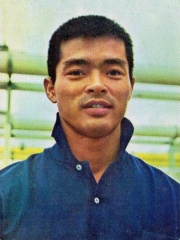
10. Shigeru Kasamatsu (b. 1947)
With an HPI of 54.53, Shigeru Kasamatsu is the 10th most famous Japanese Gymnast. His biography has been translated into 18 different languages.
Shigeru Kasamatsu (笠松 茂, Kasamatsu Shigeru; born July 16, 1947) is a retired Japanese artistic gymnast. He competed at the 1972 Olympics and won a gold medal with the Japanese team. Individually he won a silver on parallel bars and bronze medals on the floor and horizontal bar. Kasamatsu won six world titles in 1974 and 1978. The Kasamatsu vault is named after him. In 2006, he was inducted into the International Gymnastics Hall of Fame. His wife Kazue Hanyu and son Akihiro Kasamatsu are also retired Olympic gymnasts. Kasamatsu took up gymnastics in 1957, but had his first major achievement only in 1970, when he finished second all-around in the Chunichi Cup. He had to withdraw from the 1976 Olympics due to an emergency appendectomy.
People
Pantheon has 31 people classified as Japanese gymnasts born between 1919 and 2004. Of these 31, 27 (87.10%) of them are still alive today. The most famous living Japanese gymnasts include Sawao Kato, Takashi Ono, and Mitsuo Tsukahara. The most famous deceased Japanese gymnasts include Akinori Nakayama, Yukio Endo, and Masao Takemoto. As of April 2024, 2 new Japanese gymnasts have been added to Pantheon including Naoya Tsukahara, and Shinnosuke Oka.
Living Japanese Gymnasts
Go to all RankingsSawao Kato
1946 - Present
HPI: 65.77
Takashi Ono
1931 - Present
HPI: 60.82
Mitsuo Tsukahara
1947 - Present
HPI: 59.56
Haruhiro Yamashita
1938 - Present
HPI: 55.15
Shuji Tsurumi
1938 - Present
HPI: 55.00
Eizo Kenmotsu
1948 - Present
HPI: 54.56
Shigeru Kasamatsu
1947 - Present
HPI: 54.53
Kōji Gushiken
1956 - Present
HPI: 46.81
Kōhei Uchimura
1989 - Present
HPI: 44.88
Naoya Tsukahara
1977 - Present
HPI: 38.38
Daiki Hashimoto
2001 - Present
HPI: 38.27
Koji Yamamuro
1989 - Present
HPI: 36.41
Deceased Japanese Gymnasts
Go to all RankingsAkinori Nakayama
1943 - 2025
HPI: 66.13
Yukio Endo
1937 - 2009
HPI: 57.42
Masao Takemoto
1919 - 2007
HPI: 54.62
Nobuyuki Aihara
1934 - 2013
HPI: 54.32
Newly Added Japanese Gymnasts (2025)
Go to all RankingsOverlapping Lives
Which Gymnasts were alive at the same time? This visualization shows the lifespans of the 3 most globally memorable Gymnasts since 1700.

